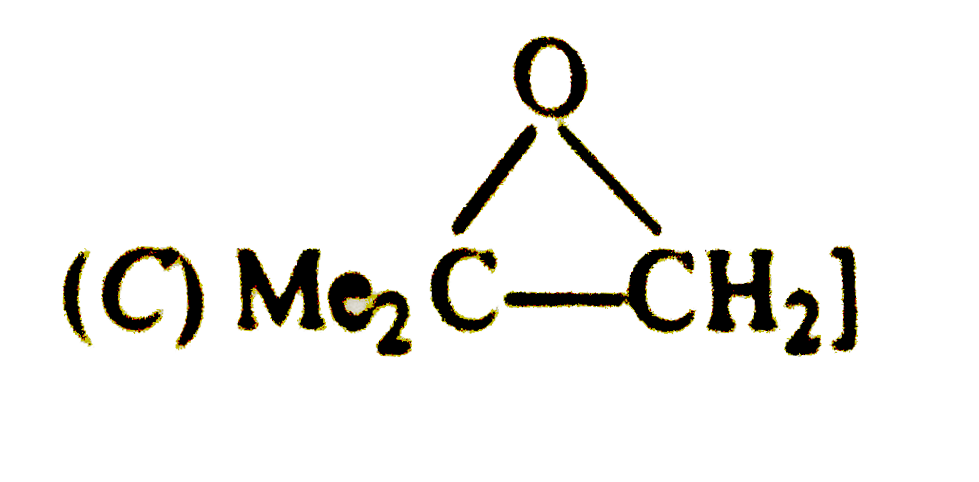CH3−C≡CHdil.H2SO4−−−−−−−−→Hg+2XBa(OH)2−−−−−−−−→ΔY,Y is
CH3−CH2−CH=CH−C∣∣O−CH3
CH3−CH3∣C=CH−C∣∣O−CH3
CH3−CH3∣C=CH−CH2−CH=O
CH3−CH2−CH=CH−CH2−CH=O
The correct Answer is:B
To solve the question, we will go through the reactions step by step.
Step 1: Identify the starting compound
The starting compound is 1-Butyne (CH₃-C≡CH).
Step 2: Reaction with Hg²⁺ and dilute H₂SO₄
When 1-Butyne reacts with mercuric ion (Hg²⁺) in the presence of dilute sulfuric acid (H₂SO₄), it undergoes hydration to form a ketone. The reaction proceeds as follows:
1. The triple bond (C≡C) is converted into a double bond (C=C) by the addition of water (H₂O) in the presence of Hg²⁺.
2. The product formed is 2-Butanone (CH₃-CO-CH₂-CH₃).
Intermediate Product (X):
X=2-Butanone (CH3-CO-CH2-CH3)
Step 3: Reaction with Barium Hydroxide (Ba(OH)₂)
Next, we take the intermediate product (2-Butanone) and react it with barium hydroxide (Ba(OH)₂) and heat it. This will lead to an aldol condensation reaction.
1. The barium hydroxide acts as a strong base, which abstracts a proton from the alpha carbon of the ketone (2-Butanone).
2. This generates an enolate ion.
3. The enolate ion then attacks the carbonyl carbon of another molecule of 2-Butanone, forming a β-hydroxy ketone.
Intermediate Product (after aldol condensation):
CH3-C(OH)(CH3)-CH2-C(=O)-CH3
Step 4: Dehydration
Upon heating, the β-hydroxy ketone undergoes dehydration (loss of water) to form an α,β-unsaturated ketone.
1. The water is eliminated, resulting in the formation of a double bond between the alpha and beta carbons.
Final Product (Y):
Y=4-Methylpent-3-en-2-one (CH3-C(=CH2)-C(=O)-CH3)
Conclusion
The final product Y is 4-Methylpent-3-en-2-one.
The starting compound is 1-Butyne (CH₃-C≡CH).
When 1-Butyne reacts with mercuric ion (Hg²⁺) in the presence of dilute sulfuric acid (H₂SO₄), it undergoes hydration to form a ketone. The reaction proceeds as follows:
2. The product formed is 2-Butanone (CH₃-CO-CH₂-CH₃).
X=2-Butanone (CH3-CO-CH2-CH3)
Next, we take the intermediate product (2-Butanone) and react it with barium hydroxide (Ba(OH)₂) and heat it. This will lead to an aldol condensation reaction.
2. This generates an enolate ion.
3. The enolate ion then attacks the carbonyl carbon of another molecule of 2-Butanone, forming a β-hydroxy ketone.
CH3-C(OH)(CH3)-CH2-C(=O)-CH3
Upon heating, the β-hydroxy ketone undergoes dehydration (loss of water) to form an α,β-unsaturated ketone.
Y=4-Methylpent-3-en-2-one (CH3-C(=CH2)-C(=O)-CH3)
The final product Y is 4-Methylpent-3-en-2-one.
Topper's Solved these Questions
Similar Questions
(i) Identify the compounds A,B,C,D,E and F.
HC≡CHdil. d2SO4−−−−−−→Hg+[A][O]−−→[B]SOCl2−−−→CCH3COONa−−−−−−−→Δ[D]C6H5OH−−−−→Δ[F]NH2OH−−−−→[E]
(ii) Write the relevant balanced equation and the name of the reaction involved in the conversion of acetyl chloride to acetaldehyde.
View SolutionCH3CH∣CH3−CH=CH2(i)B2H4−−−−−−−−−→(ii)H2O2/OHXH2SO4−−−→140∘Y
What is Y ?
View Solution
Knowledge Check
In the given reaction:
Ph−C∣∣O−CH3H2N−OH−−−−−−−−→H⊕(X)PCl5−−−−−→Δ(Y) Y will beAPh−C∣∣O−NH−CH3BH3C−O∣∣C−NH−PhCPh−CH2−O∣∣C−NH2DPh−CH2−CNSupply structural formulae for missing compounds.
(i) H2C=CH2+(A)→ClCH2−CH2OHH2SO4−−−−−−→413K(B)alc. KOH−−−−−−−→Δ(C)
(ii) CH3CHBrCH3alc. KOH−−−−→(A)HBr−−−−−→Peroxide(B)CH3ONa−−−−−→(C)
(iii) Me3CBralc. KOH−−−−→(A)HOCl−−−→(B)NaOH−−−→(C)
 AABCCH3CH=CH2CH3CH(Br)CH2BrCH3CH(OH)CH3BABCCH3CH=CH2CH3CH2CH2BrCH3CH2OCH2CH2CABCCH2CH=CH3CH3CH(Br)CH3CH3CH2OCH2CH2DABCCH2CH=CH3CH3CH2CH2BrCH2CH2CH2OCH3
AABCCH3CH=CH2CH3CH(Br)CH2BrCH3CH(OH)CH3BABCCH3CH=CH2CH3CH2CH2BrCH3CH2OCH2CH2CABCCH2CH=CH3CH3CH(Br)CH3CH3CH2OCH2CH2DABCCH2CH=CH3CH3CH2CH2BrCH2CH2CH2OCH3CH3CH2CH2OHconc. H2SO4−−−−−−−−→170∘CACl2−−−→500∘CB.
A and B. areAA=CH3CH2CH3,B=CH3CH2CH2ClBA=CH3CH=CH2,B=CH2ClCH=CH2CA=CH2=CH2,B=CH3CH2ClDA=CH3CH2CH3,B=CH3CH=CH2
Choose the correct code by identifying (X), (Y) and (Z) in each case for the changes indicated:
(i) CrO2Cl2KOH−−→(X)conc. H2SO4−−−−−−−−→(Y)AgNO3−−−→(Z)
(ii) CrCl3(aq)excess−−−→NaOH(X)Na2O2−−−−−−→H2O, boil(Y)lead−−−→acetate(Z)
(iii) ZnSO4(aq)Na2CO3−−−−→(X)Δ−−→(Y)cobalt−−−−−−→nitrate, Δ(Z)
(iv) CuCl2(aq)NH4OH−−−−→H2S(X)HNO3−−−→Δ(Y)KCN−−→excess(Z)
View SolutionX(Black)Dil.H2SO4−−−−−−→Y(gas)Dil.HNO3−−−−−−→ Colloidal sulphur identify X?
View SolutionCH3−O∣∣C−OHCa(OH)2−−−−−→Δ(A)
Product (A) is :
View SolutionH3C−C≡CH1.NaNH2−−−−−−−→2.CH3CH2BrAH2−−−−−−→Pd−BaSO4B :
View SolutionIn the following sequence of reaction, the final product (Z) is
CH≡CHHg2+−−−→H2SO4XCH3MgX−−−−−→H2OY[O]−−→Z
View Solution